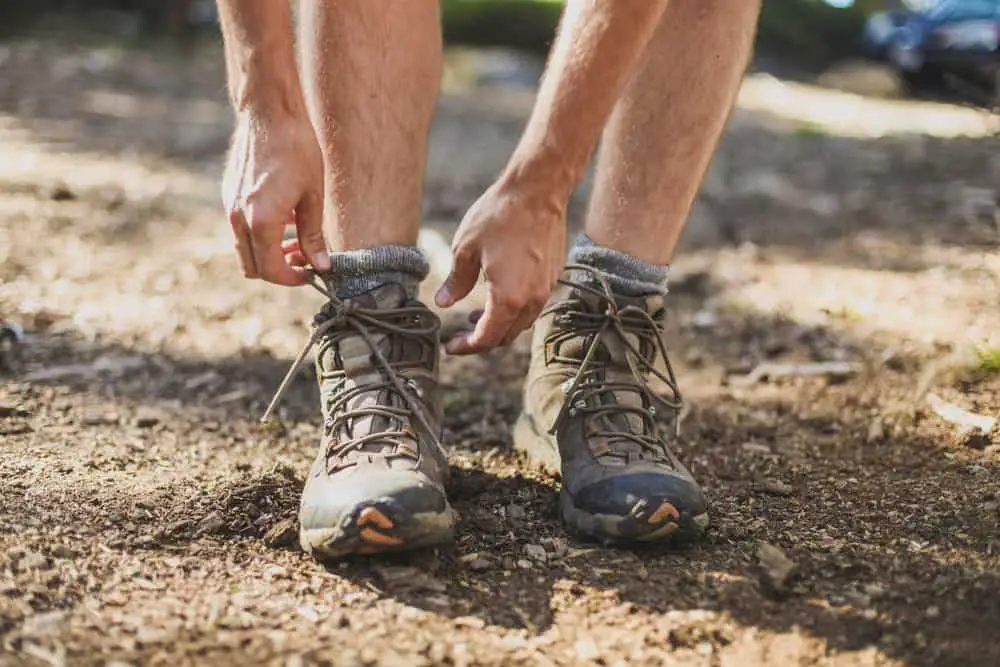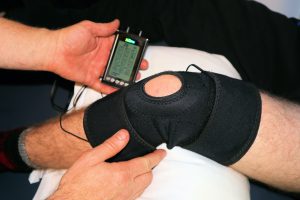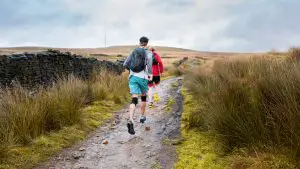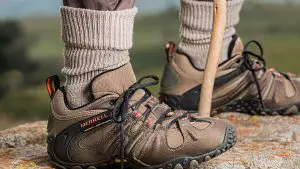Hikers Toenail: 5 Reasons Hiking Is Hurting Your Toenails

Anyone who’s a big fan of long hikes has probably had a few run-ins with the dreaded “hiker’s toenail.”
You probably already know the importance of taking care of your feet. One of the most common injuries for hikers is toenail damage. In this post, we’ll discuss how to prevent toenail damage, and what to do if you experience it. We’ll also provide some tips for treating and healing toenails quickly. So whether you’re just starting out on your hiking adventures, or are a seasoned pro, read on for information that can help keep your feet healthy!
Quick Links
What Is a Hikers Toenail?
For those who don’t know what hiker’s toenail is or haven’t yet experienced it, lucky you. It can be a very painful, unpleasant, and unsightly experience for hikers.
Hiker’s toenail refers to the toenail damage and loss avid hikers can experience over time. Many outdoor enthusiasts look at this condition as a badge of honor or a rite of passage.
Although a particular group of hikers may hold a hiker’s toenail in high regard, the toenail damage that comes with this condition can be dangerous. It can potentially lead to longer-term problems such as misshapen toenails and fungal infections.
How Do You Treat a Bruised Toenail from Hiking?
When you have a hiker’s toenail, you can develop a black and bruised appearance on one or several of your toenails. This happens after your feet take a beating during a hike. This condition can make hiking, climbing, and other physical activity difficult and uncomfortable. Secondly – the warm, moist environment inside of your shoes is the perfect home for bacteria where fungal infections can develop.
If you leave this blackened toe untreated, there can be dire long-term consequences. At a certain point, knowing how to treat a hiker’s toenail at home will be of no help, and you might require more drastic treatment.
Hiker’s toenail is entirely avoidable when you know the proper prevention methods.

How Does Hiker’s Toenail Happen?
Before we get deeper into how to best prevent this dreaded yet laureled condition, let’s get into what causes hiker’s Toenail.
Wearing shoes or boots that don’t fit properly.
When you wear shoes or boots that are too short or can allow your foot to slide forward can cause your toes to press hard up against the tips of your boots. The toenail in turn can get damaged or begin to develop an ingrown nail from all that unnecessary pressure.
If your toes are allowed to keep pressing up against your boot like this, the nail can lift off the nail bed completely. This is painful on its own and can also lead to a blood blister that can form in the nail bed. Fungus can also creep its way into there, where it can develop into a very nasty fungal toenail infection.
This pressure that your toes experience when you don’t wear properly fitting hiking boots can be severe. Many hiking experts will advise you to get yourself a pair of hiking boots or shoes that are at least a half size bigger than what you would typically wear with regular shoes.
This means that when you wear your hiking boots, your feet and toes have a reasonable amount of room to keep sliding inside as you hike.
Letting your toenails get too long
If you keep your toenails long, wearing fitting hiking boots actually damages your toes. Your long toenails will eventually begin pressing into the sides of your toes any time your foot slides forward a little. This can not only cause a significant amount of discomfort and pain but can contribute to a gnarly ingrown toenail.
Therefore, keep your toenails as short as possible. Both experiences are painful and can lead to the dreaded blackened toenail with a side of fungus. To prevent this from happening, regularly trim your toenails.
Flattening of the arch
If you don’t properly support your feet, the arch of your foot can flatten, causing more of your foot to fill in the boots. This means that your feet will become too long for your boots. This, in turn, can cause your toes to put more pressure on the tips of your shoes, which again is a big no-no when it comes to hiking.
Socks that are too thick
Sort of like the flattening of the arch, wearing socks that are too thick will also increase the volume in your boots. Opt for a more dynamic sock that can hug and support your foot correctly that doesn’t take up a lot of volume. If insulation is an issue, and you find yourself wanting to go for a cozier sock when you’re hiking in the snow, consider getting a hiking boot that is specially made for cold conditions or hiking socks.
Improper boot lacing
When your hiking boots are not properly laced, you put your feet at a higher risk of sliding forward, particularly when you’re hiking downhill. This can be an especially problematic condition for hikers with more narrow heels.
Consider lacing up your boots in an overhand locking style. This pattern of lacing is a simple style where the lace forms X-crosses as it goes through the holes of the opposite side.
The primary benefit of lacing your boot up in this style is that it keeps your foot secured tightly in the shoes. This is beneficial, especially when hiking downhill, ensuring that your foot does not slide in the boots.
Now that we’ve covered how it happens, let’s move on to preventing it and keeping you safe on the trail.
Can your toenails fall off from hiking?
The reality is that toenails can fall off from hiking, but it’s not as common as one might think. In most cases, the toenails will simply become bruised, cracked, or blackened from the hike. If you take care of your feet and nails properly during and after the hike, then there is a good chance that your toenails will return to their normal state.
How To Prevent Hiker’s Toenail
In most cases, your toes start to experience this discomfort when you have been going downhill because your foot slides forward in your shoe. That said, there are a few things that you can do to help increase the chances of your toenails staying healthy and intact during and after your hike:
Use trekking poles when going downhill
One great reason to use trekking poles for hiking is that they support you so that all of your weight isn’t all in your legs and feet. Even if your toenails do not hurt when you are going downhill, using hiking poles is especially beneficial if you’re hiking with a heavy backpack.
Wear special hiking socks
Hiking socks are an incredibly fundamental piece of clothing to have when you’re ready to get your hike on.
A solid pair of merino wool hiking socks can act as an excellent cushion between your foot and boot. This will pad down the beating your feet will take on the hiking trail. Another underrated benefit of having a good pair of hiking socks is the additional traction & moisture wicking you will get, preventing foot slippage, potential fungal infections, and toe banging when on the trail.
Keep your feet dry
If you take anything from this article, take away that keeping your feet dry when you’re hiking is a major key to your feet’s health. Fungal infections can have a sneaky way of creeping up on you. The inside of your boots is likely already a bit moist from the sweat you build up while on your trail.
You can also get moist boots from external factors such as stepping in a puddle or rainfall. If this precipitation is given the chance, or if you hike with wet boots, you can get a nasty fungus infection.
I had an athlete’s foot fungal infection that I got from the gym. It happened after wearing wet/sweaty socks the rest of the day. (I know, I know, rookie mistake). Take it from me – It’s not a fun experience at all.
To prevent this, remember to hike with dry feet, clean boots, and if you can, resist walking around your campgrounds with bare feet. Walking around barefoot on your camp may feel incredible and connecting, but it’s just another excellent way to develop a fungal infection.
There are a few things you can do to help here: Bring an extra pair of hiking socks, wear water-resistant hiking boots, use a baby powder/anti-fungal powder to absorb any moisture, and wear moisture-wicking hiking socks.
When I had a bad case of athlete’s foot, I used Zeasorb’s Antifungal Powder nearly every day, for over a year. I can highly recommend this product, even if you DON’T have athletes’ foot or fungal infections. Keeping your feet dry is the best preventative measure.
Now you’ve done all you can do to prevent Hiker’s Nail, but you still got it! Now what?
What If The Preventative Measures Don’t Work?
If you are not experiencing a great amount of pain, then it’s likely that your toenail will simply just grow out. In that case, additional help or medication isn’t needed.
If you experience a pool of blood under the nail that continues to raise or develop some swelling, consider seeing a podiatrist. The foot doctor will help to relieve some of the pressure by drilling a hole or two in the nail plate. This is a painless procedure called trephination.
In a more severe case of hiker’s toenail, where you find your toenail is becoming raised off the nail bed, you will likely have to wait to lose the nail. It’s best to let this nail fall off naturally or allow the damaged nail to be pushed out by the new growth. Yanking your damaged toenail off prematurely will cause more irritation and discomfort to an already damaged nail bed.
Once you’ve gotten over your hiker’s toenail, you must remember to take proper steps to prevent it from happening again. Repeated damage to the nail can result in permanent changes such as thickening or ridging the nail. Not only will it be an unpleasant sight to look at, but it will also keep you off the trail for more extended periods.
Conclusion
So, there you have it. Now that you know how to keep your toenails safe while hiking and camping, make sure to take the correct preventative measures. Pack a good pair of shoes, socks (maybe an extra pair), and nail clippers (just in case). And if all else fails and you do end up with a nasty infection or ingrown nail, don’t be afraid to ask for help from a friend or doctor. We hope you enjoy your next outdoor adventure—and don’t forget to protect those feet!







